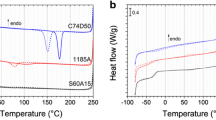Abstract
The article discusses the synthesis and properties of electrically conductive polymer composite materials based on low-ash graphite grade GSM-1, modified with acids using bisulfate technology. Investigations of the influence of such technological methods as pressing and rolling on rollers with a variable gap on the conductivity of composite materials based on thermally expanded graphite and thermally expanded polymer-graphite compositions containing acid-modified graphite have been carried out. It is shown that, by applying to polymer composites the technological methods of thermal expansion, pressing, and rolling on rollers, it is possible, firstly, to combine fillers of different nature, shapes, and sizes and, secondly, to obtain composites with the required conductivity of an electrically conductive polymer composite. The paper shows the advantage of using thermally expanded graphite in comparison with other forms of graphite to obtain highly conductive polymer compositions.



Similar content being viewed by others
REFERENCES
Savvinova, M.E., Electroconductive polymeric composite materials of electrotechnical appointment, Izv. Vyssh. Uchebn. Zaved., Severo-Kavkazsk. Reg. Ser. Tekh. Nauki, 2015, no. 4, pp. 44–49.
Liaw, D., Huang, Y., Chang, C., Rumyantsev, B.M., Lozinova, T.A., Zubov, V.P., Olkhov, A.A., Bagratashvili, V.N., Zaikov, G.E., and Ischenko, A.A., Photoelectron properties and paramagnetism of polyimides based on N,N,N′,N′-substituted p-phenilenediamine and dianhydrides, Chem. Chem. Technol., 2015, vol. 9, no. 4, pp. 445–452.
Pomogailo, A.D., Polymer-immobilised nanoscale and cluster metal particles, Russ. Chem. Rev., 1997, vol. 66, no. 8, pp. 679–716. https://doi.org/10.1070/RC1997v066n08ABEH000283
Shevchenko, V.G. and Ponomarenko, A.T., Transport processes in electrically conducting dispersely filled polymeric composites, Russ. Chem. Rev., 1983, vol. 52, no. 8, pp. 757–765.https://doi.org/10.1070/RC1983v052n08ABEH002881
Chernysh, I.G., Karpov, I.I., Prikhod’ko, G.P., and Shai, V.M., Fiziko-khimicheskie svoistva grafita i ego soedinenii (Physicochemical Properties of Graphite and Its Compounds), Kiev: Naukova Dumka, 1990, pp. 140–152.
Gorshenev, V.N., Ovchinnikov, A.A., and Novikov, Yu.N., Magnetically active graphites for sorption of petroleum hydrocarbons, Zh. Fiz. Khim., 2001, vol. 75, no. 6, pp. 1058–1062.
Gorshenev, V.N., Bibikov, S.B., and Novikov, Yu.N., Conducting materials based on thermally expanded graphite, Russ. J. Appl. Chem., 2003, vol. 76, no. 4, pp. 603–606. https://doi.org/10.1023/A:1025743305284
Levit, R.M., Elektroprovodyashchie volokna (Electrically Conductive Fibers), Moscow: Khimiya, 1986, pp. 15–20.
Zaikov, G.E., Klodzinska, E., and Stoyanov, O.V., Progress in polymer, composite and monomer chemistry and physics, in Effect of Rolling on Properties of Isotropic and Oriented Polystyrene Film, Inst. Eng. Polym. Mater. Dyes, Torun Div., Poland, 2014, pp. 123–130.
Gorshenev, V.N. and Demin, V.L., Electrically conductive composite materials based on plasticized PVC, Naukoem. Tekhnol., 2007, vol. 8, no. 12, pp. 80–85.
Gorshenev, V.N. and Shchegolikhin, A.N., Thermophysical studies of the expansion of graphite in thermoplastic polymeric compositions, Russ. J. Phys. Chem. B, 2008, vol. 2, no. 1, pp. 123–127. https://doi.org/10.1134/S1990793108010181
Author information
Authors and Affiliations
Corresponding author
Ethics declarations
It has been shown that, applying to polymer composites the technological methods of thermal expansion, pressing, and rolling on rollers and other methods, one can, firstly, combine fillers of different nature, shapes, and sizes and, secondly, obtain composites with the required conductivity of the electrically conductive polymer composite.
The advantages of using TEG in comparison with other forms of graphite for the production of highly conductive polymer-graphite composites, as well as the positive role of the expansion of modified graphites in the polymer matrix and the technological method of rolling for the formation of a branched structure of electrically conducting paths in the polymer matrix, are shown.
It has been established, using the example of thermoplastic polymer-graphite composites, that the formation of conductive paths when using rolling techniques is influenced by the rheological properties of the binder.
Additional information
Translated by M. Drozdova
Rights and permissions
About this article
Cite this article
Gorshenev, V.N. Influence of Technological Conditions in the Formation of Electrically Conductive Thermoplastic Polymer-Graphite Composites. Inorg. Mater. Appl. Res. 13, 515–522 (2022). https://doi.org/10.1134/S2075113322020149
Received:
Revised:
Accepted:
Published:
Issue Date:
DOI: https://doi.org/10.1134/S2075113322020149




